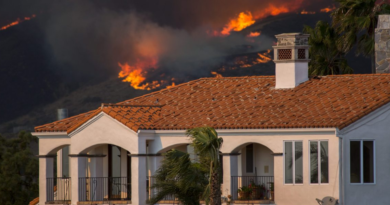Wealthy travelers seeking sun, sand, and luxury are flocking to the Caribbean paradise next to Haiti, where armed gangs dominate
The Dominican Republic is having a moment. Ten million tourists a year are flocking to its beaches, helping drive one of the region’s best performing economies. Poverty is near a record low, and investment at an all-time high. Even Fast & Furious star Vin Diesel wants to build a movie studio there.
Its success stands in stark contrast to the country on the other side of the Caribbean island of Hispaniola, Haiti, where spiraling crime and violence are ruining the nation.
President Luis Abinader is taking credit for the boom in the Dominican Republic, pointing to his pro-business, low-drama governing style that has made the nation the darling of investors and tourists. In the process, it’s also made him the front-runner in Sunday’s presidential election.
The vote is “a referendum on the actions we’ve taken during these last four years,” Abinader wrote in a social media post earlier this week. “The best is yet to come.”
The Dominican Republic’s economy is forecast to grow 4.4% this year. The country of 11 million people recently leapfrogged Ecuador (population 18 million) to become the hemisphere’s seventh-largest economy.
But critics say the growth has come with rising government debt, swollen social programs and fears that the chaos in Haiti might spillover.
“The government has been very good at marketing the idea of economic wellbeing that people on the street simply don’t feel,” said Leonel Fernández, who was president from 1996-2000 and again in 2004-2012, and is the No. 2 contender in this weekend’s vote.
Surveys show that inflation, the economy, crime and Haiti are among voters’ top worries. But those same surveys also show Abinader cruising toward reelection.
Abinader and his Modern Revolutionary Party are poised to get 60% of the vote, followed by Fernández and his People’s Force party with 25%, according to a poll by Gallup-RCC Media published by Diario Libre on May 9. Abel Martínez, with the Dominican Liberation Party, trails with 11% support. Other polls show a tighter race, but with Abinader still leading.
If any candidate takes more than half the vote, he’ll be the winner. Otherwise, the top two will compete in a June 30th run-off, where Abinader could face a much tighter race.
Abinader, 56, acknowledges the risks that Haiti poses to the Dominican Republic, but rejects the idea that his country has a special responsibility to repair the neighboring nation. Powerful gangs in Haiti have seized large parts of the capital as violence and hunger have swept the nation. The country recently installed a transitional governing council and is expecting to receive a Kenyan-led multinational security force, but chaos still reigns.
While Haiti and the Dominican Republic share a 240-mile border, they’re worlds apart. Abinader is trying to keep things that way, prioritizing the construction of a border wall, stepping up deportations and exhorting the international community to intercede.
Haiti “is one of the biggest challenges the Dominican Republic has faced in several decades,” Abinader said at an event in Washington last week. Shoring up border security has “drained resources that we needed for economic development.”
Wall Street seems to approve of Abinader’s strategy. While he’s boosted the government’s debt load by 30% during his term in office, the extra yield investors demand to hold the country’s overseas bonds has fallen by more than half since mid-2022, according to data from JPMorgan Chase & Co. Barclays Plc and BancTrust recommend investors buy the dollar-denominated securities. Money managers from Vontobel Asset Management to M&G Investment Management and Eaton Vance also tout the country’s local notes.
“The government has actually done a pretty good job and not just to please investors, but also a good job in terms of pleasing its own population,” said Carlos de Sousa, a portfolio manager at Vontobel Asset Management in Zurich.
Tourism Wave
Abinader was the executive president of Grupo Abicor, a construction firm owned by his family that focuses on tourism development, and a director at the National Association of Hotels and Restaurants, before winning the 2020 election with 53% of the vote.
As president, he’s stayed in his wheelhouse. After the pandemic, the Dominican Republic reopened to tourists far sooner than most Caribbean nations, and it’s still reaping the rewards. Last year, the country welcomed more than 10 million visitors, a record. (International tourism has collapsed in Haiti, as airlines suspended flights and Royal Caribbean stopped cruises to its private peninsula in Haiti.)
Abinader is promoting the industry as a way to bolster neglected corners of the country and diversify the economy. Over all, the government says there are 19 major projects in the works worth more than $2.9 billion — from cruise ports and airports to massive hotel projects.
Yet for many Dominicans, the crush of visitors is associated not with progress but rising prices and gentrification. Housing costs jumped 24% from 2020 to 2024, and increases were even bigger in tourist-heavy areas where there’s been an influx of foreign buyers.
“The general narrative in the country is that tourism is going to save us and bring us work and income,” said Moraima Capellán Pichardo, who works with an environmental group called Cabarete Sostenible. “But what we’re seeing is people being displaced because of rising prices, and houses being built that no local here could ever afford.”
Few projects capture the government’s strategy like Punta Bergantín. On 2,400 acres of beachfront on the northern coast, the government is promoting an eco-friendly resort it says will include 4,000 hotel rooms, more than 2,000 residences, a golf course, a hospital, a waterpark and a tennis club.
Tourism officials say they already have commitments from Grupo Puntacana, in alliance with Melia Hotels International; Grupo Martinón, which runs the Hyatt Ziva and Hyatt Zilara brands; and Karisma Hotels.
Andrés Marranzini, who’s heading the Punta Bergantín project, says more than half of the $800 million needed for the first stage has been committed.
The project is also set to include a 148-acre movie lot. Fast and Furious star Diesel’s One Race Films signed a memorandum of understanding with Abinader in 2021 to develop it. One Race Firms referred calls about the effort to its talent agency, which didn’t return emails and messages. Marranzini said the project is “definitely happening.”
Last month, officials announced Bergantín will also include an innovation hub, which it’s calling “Silicon Beach.” They envision drawing together government agencies, academia and the private sector to create a tech incubator and accelerator. Officials haven’t put a price tag on the complex yet.
One of the nation’s larger goals is to become a manufacturing center for semiconductors for a US market that’s trying to wean itself off of Asia. While that target is still far away, these types of projects could attract the type of talent and workers needed to make that a possibility, according to Economy Minister Pável Isa Contreras.
Juan Ureña, a 74-year-old carpenter, visited Bergantín on a recent weekend after hearing campaign ads on the radio that made him believe the area was ready to begin hosting thousands of tourists and Hollywood A-listers. But aside from a newly paved road and a sign warning him to keep out, there wasn’t much to see.
“They’ve been talking about this for years now and there’s nothing here,” Ureña said, standing next to a thickly wooded lot by the beach. “I feel like they’re just talking this up to get our votes.”
The government says its broader vision for the country will take time, and construction at Punta Bergantín will begin in earnest in August — the same month Abinader hopes to begin his second term.




